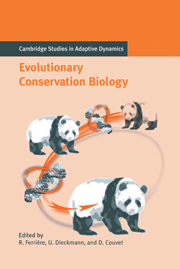Book contents
- Frontmatter
- Contents
- Contributing Authors
- Acknowledgments
- Notational Standards
- 1 Introduction
- Part A Theory of Extinction
- Part B The Pace of Adaptive Responses to Environmental Change
- Part C Genetic and Ecological Bases of Adaptive Responses
- 9 Fixation of New Mutations in Small Populations
- 10 Quantitative-Genetic Models and Changing Environments
- 11 Adaptive Dynamics and Evolving Biodiversity
- Part D Spatial Structure
- Part E Community Structure
- References
- Index
- The International Institute for Applied Systems Analysis
9 - Fixation of New Mutations in Small Populations
Published online by Cambridge University Press: 15 August 2009
- Frontmatter
- Contents
- Contributing Authors
- Acknowledgments
- Notational Standards
- 1 Introduction
- Part A Theory of Extinction
- Part B The Pace of Adaptive Responses to Environmental Change
- Part C Genetic and Ecological Bases of Adaptive Responses
- 9 Fixation of New Mutations in Small Populations
- 10 Quantitative-Genetic Models and Changing Environments
- 11 Adaptive Dynamics and Evolving Biodiversity
- Part D Spatial Structure
- Part E Community Structure
- References
- Index
- The International Institute for Applied Systems Analysis
Summary
Introduction
Evolution proceeds as the result of a balance between a few basic processes: mutation, selection, migration, genetic drift, and recombination. Mutation is the ultimate source of all the genetic variation on which selection may act; it is therefore essential to evolution. Mutations carry a large cost, though; almost all are deleterious, reducing the fitness of the organisms in which they occur (see Chapter 7). Mutation is therefore both a source of good and ill for a population (Lande 1995).
The overall effect of mutation on a population is strongly dependent on the population size. A large population has many new mutations in each generation, and therefore the probability is high that it will obtain new favorable mutations. This large population also has effective selection against the bad mutations that occur; deleterious mutations in a large population are kept at a low frequency within a balance between the forces of selection and those of mutation. A population with relatively fewer individuals, however, will have lower fitness on average, not only because fewer beneficial mutations arise, but also because deleterious mutations are more likely to reach high frequencies through random genetic drift. This shift in the balance between fixation of beneficial and deleterious mutations can result in a decline in the fitness of individuals in a small population and, ultimately, may lead to the extinction of that population. As such, a change in population size may determine the ultimate fate of a species affected by anthropogenic change.
- Type
- Chapter
- Information
- Evolutionary Conservation Biology , pp. 155 - 170Publisher: Cambridge University PressPrint publication year: 2004
- 21
- Cited by



